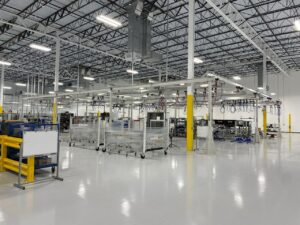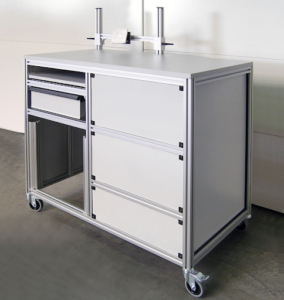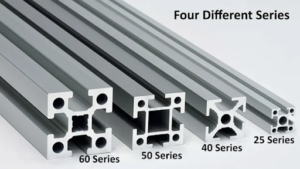Let’s paint a picture: you walk through the entrance of a facility. High ceilings and robotic arms surround you, with workers moving to and fro. Carts, tables, and shelving are everywhere.

Source: Black Line Group
But, what are all these things made of? How can they withstand such a busy, and potentially dangerous, environment?
When it comes to manufacturing, each facility is uniquely crafted, but the needs of each facility are similar: You need the right technicians and the right components to work together seamlessly.
Aluminum plays an enormous role in the workings of most manufacturing facilities. Most workbenches, carts, and tables are crafted using aluminum. More specifically, aluminum profiles. And to understand how aluminum is used in all these applications, we must first go through exactly what “aluminum profiles” are.
What are Aluminum Profiles?
An aluminum profile, simply put, is a shape made of metal, used to build different types of structures that are used in a majority of manufacturing facilities.
Aluminum profiles start with aluminum blanks being heated to an extremely high temperature and then forced through a process to form different sizes and shapes. This process, also known as the extrusion process, ultimately gives us an aluminum profile’s final form.
Think of it like Legos – different pieces in diverse shapes and sizes that ultimately fit together and can be built into all sorts of different structures.

Source: Raw Pixel
Aluminum profiles, in all their shapes and sizes, then get shipped to facilities where workers turn them into sturdy benches, tables, carts, and more.
Because they’re durable and can withstand the environments of a manufacturing facility, aluminum profiles can help you create the materials you are looking for.
Aluminum Profiles: Use and Applications
Aluminum profiles are found in numerous products within manufacturing facilities, including workbenches, tables, and carts.


Source: mk North America
For any type of shape or structure you are looking to create, you will most likely be able to use aluminum profiles to complete your build. Because of the extrusion process, you’ll have a large variety of shapes available to you (flat, round, etc), which can help your builds come to life.
Since aluminum profiles face such high temperatures during manufacturing and are so durable, they are acclimated to serve in environments like manufacturing facilities, where mishaps are always a risk.
So, are all aluminum profiles manufactured the same? While the process is pretty consistent from one manufacturer to another, we at HESCO have a particular vendor we prefer. We are not monetarily endorsed by mk North America to recommend their business, but we will explain why we do recommend them.
mk North America & Their Approach
mk North America is a manufacturer located in Connecticut that boasts expertise in aluminum profiles and conveyors, and they are able to reach international markets with their high-quality products.
mk’s aluminum profile debuted in 1982 and has since evolved, maturing into a distinct presence over the past 40+ years.
So, what makes mk unique?
According to HESCO’s Account Manager Seth Gorry, mk has created long-lasting products that have used been in manufacturing facilities, and the quality of the product has made customers want to come back for more.
Seth also praises their customer service for creating an environment of trust in mk’s company and products.
However, it’s worth noting that mk’s profile is metric, which could create a roadblock if you were to buy from them. In the world of manufacturing in the United States, it is actually uncommon for the metric system to be utilized. Because of this, mk’s utilization of the metric system could be a learning curve if you were to move forward with their profile.

Source: mk North America
Choosing Your Provider
Though we can recommend certain manufacturers to you, we ultimately believe having a good and trustworthy aluminum profile provider is essential to your manufacturing facility.
Ensure your manufacturing facility is fully equipped with high-quality products and make sure you look at all of your options before truly making a decision on who you would like to provide your aluminum profiles.
To move forward with making this decision, be sure to know the properties required for your product, the surface finish, the strength and formability, the temperature at which the metal can reach without corroding, and the size you are looking for. This will assist you in choosing the right provider.
If you ever need help sourcing the materials you need, talk to our team at HESCO for advice you can trust.
